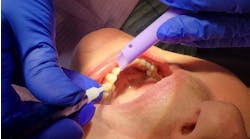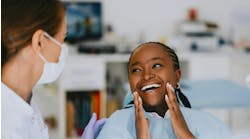IDHEF Forum, part 3: The long reach of corporate education in dental hygiene
By Maria Perno Goldie, RDH, MS
The Third International Dental Hygiene Educator’s Forum was held March 17 in Long Beach, Calif., prior to the American Dental Education Association (ADEA) meeting. The meeting was created by Sylvia Fresmann, DH, and Maria Perno Goldie, RDH, MS. Mare than 65 participants, speakers, and sponsors from the United States, Canada, Portugal, Australia, Germany, and Japan attended.
This article is the third in a series about the International Dental Hygiene Educator’s Forum (IDHEF). This article will focus on corporate professional educators involved with the program. To see the first and second articles, click here and here.
We were fortunate to have wonderful and generous sponsors for this meeting: Philips, Dentsply Sirona, Colgate, and P&G.
Cindy Sensabaugh
Cindy Sensabaugh, CRDH, MSDH, Philips North America manager of professional education and academic relations, and Gail B. Stoops, RDH, BSDH, senior manager of professional relations in the U.S. and Canada, Philips distributed Sonicare FlexCare Platinum Connected electric toothbrushes to every participant. In addition to product information, Philips Oral Healthcare is continually adding to the online catalog of educational materials and resources for clinicians and patients, including clinical studies, office literature and videos. To learn more about these state of the art toothbrushes, clinical studies, other resources and education, visit the professional website of Philips.
Shirley Beaver, RDH, MS, PhD, from Fox College and Katherine Woods, MPH, PhD, CRDH, from St. Petersburg College gave a presentation titled, Using CARE to Foster Critical Thinking Skills. Their objectives were to provide knowledge of disease indicators and risk factors associated with oral disease to complete a risk assessment, so that those present could further develop clinical protocols to manage oral disease and promote oral health. They provided resources and tools for routine comprehensive patient screenings, so participants could use the CARE tool assessment data to provide evidence-based, patient-centered care.
L to R: Cindy Sensabaugh, Katie Woods, Shirley Beaver
Gail Y. Malone, RDH, BS, the global professional services senior manager of clinical affairs of Dentsply Sirona Preventive presented Curricula for Ultrasonic Instrumentation, Aligning the Curriculum According to the Evidence. Gail discussed the rationale for introducing ultrasonic instrumentation earlier in the students’ curriculum, while recognizing there could be resistance and perceived obstacles to introducing this concept earlier among faculty at dental hygiene schools. Gail mentioned the need to have more foundational instruction in ultrasonics similar to hand instrumentation, and why it is important to support the development of a dental hygiene graduate who is competent at both instrumentation techniques.
Gail Malone
Things have changed! We know now that power scaling can effectively treat a wide range of patient needs from maintaining oral health to treating patients with periodontal disease. Power scaling is an efficient and effective means for full-mouth debridement, and proper technique and tip selection is necessary for success in thorough debridement. The basics fundamentals of hand instrumentation apply to powered instrumentation. Instructions must include: adaptation of the working-end must be precise, angulation must be correct, and activation of the instrumentation stroke must be precise.
According to a survey by the Ultrasonic Scaling Teaching Institute (USTI), the greatest challenges to teaching ultrasonic instrumentation are curriculum, time, technique, and faculty calibration. The aim of the company in their research is that the findings will influence future curriculum changes in dental hygiene education programs, thereby reflecting a contemporary approach to ultrasonic instrumentation in preparing dental hygiene students to deliver evidence-based periodontal therapies.
Gail left us with a quote: “The profession has yet to complete the shift…the reasons…likely being an unwillingness to let go of long-held misperceptions about the superiority of manual instrumentation.” (George MD, Donley TG, and Preshaw PM. Ultrasonic Periodontal Debridement: Theory and Technique. September 2014, ©2014, Wiley-Blackwell. Page 35.)
Phyllis Martina
Dental corporation can help you in your practice in many ways. They teach specialized subjects live and online, provide scientific information on treatment and products for student and patient use, and provide best practices on the products use. Corporate representatives are often well qualified dental hygiene professionals with significant teaching and/or business experience, and may be former faculty members. Corporations such Colgate want faculty and students to get a variety of experiences, want to help develop and exercise critical thinking skills, and of course, want your loyalty.
There are benefits to working with corporations, especially for faculty members. It frees your time, expands your course offerings and educational resources, provides poster research and class room discussion topics, and helps to develop informed professionals who use their critical thinking skills in their professional lives.
Phyllis also mentioned that the Journal of Evidence-Based Dental Practice (JEBDP) is seeking articles describing dental hygiene/dental practice in various countries. The “Annual Report on Dental Hygiene” is a special issue of the JEBDP, published initially in 2014 and again in 2016. If interested contact [email protected].
And last, but not least, P&G/Crest-Oral-B was represented by Amy Kinnamon, RDH, EFDA, BASc, P&G’s North America professional and scientific relations manager. Mário Rui Araújo, PhD candidate, M. Psych, BSDH, RDH, and his presentation Innovations in Oral Care Instruction – A SMART approach, was sponsored by Crest/Oral-B. Mario’s presentation was featured in Part 1 of this series.
We are already working on the fourth IDHEF!











